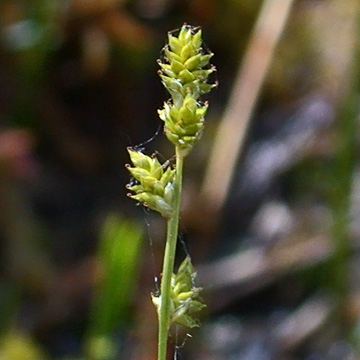

Carex canescens - (image 1 of 3)
Taxonomy
Family: Cyperaceae
Section Glareosae
Habitat
Swamps and bogs.
Associates
Distribution
Circumboreal, south to VA, OH, MN, AZ, and CA.
Morphology
Tufted perennial from short rhizomes; stems 20-60 cm; leaves grayish-green, clustered near the base, often shorter than the culms, flat, 1.5-3.5 mm wide; spikes 4-8, gynaecandrous, 5-10 mm, sessile, the upper approximate, the lower usually somewhat remote, gray-green, becoming pale-stramineous; pistillate scales mostly shorter than the perigynia; perigynia mostly (10-)15-30, ascending, mostly 1.8-2.5 mm, planoconvex, not thin-edged, somewhat corky-thickened proximally, elliptic or elliptic-ovate, with a minute beak apiculation to 0.5 mm, finely nerved on both faces, the ventral nerves fewer than the dorsal; dorsal suture short and inconspicuous, to 0.4(-0.7) mm or nearly obsolete; achene lenticular, filling the perigynium.
Notes
Fruiting June to August
Wetland indicator: OBL
A similar species, C. brunnescens, has fewer perigynia per spike (mostly 5-10, up to 15) lacking ventral nerves or the ventral nerves obscure. In C. brunnescens the perigynia tend to be more spreading and therefore they more noticeably interrupt the outline of the spike than they do in C. canescens.
References
Gleason, Henry A. and A. Cronquist. 1991. Manual of Vascular Plants of
Northeastern United States and Adjacent Canada. Second Ed.
The New York Botanical Garden. Bronx, NY
|
© Michael Hough 2018 |